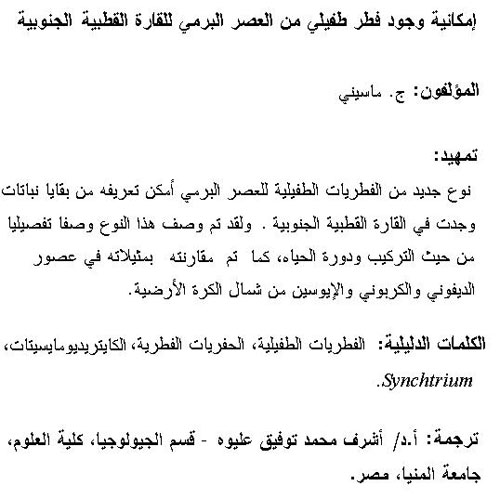|
The first fossil fungal endoparasite from the Permian (~ 250 million years ago) is described and assigned to the extant fungal group Chytridiomycetes, in particular to the genus Synchytrium within the family Synchytriaceae. This is also the first record of a fossil fungal endoparasite from Antarctica. Based on the large number of fungal structures, including zoospores, and thin- and thick-walled sporangia, fossilized within plant remains showing various degrees of decay, a life cycle for the fungal endoparasite was reconstructed. Comparison of this fossil life cycle to that of modern fungi supports the fossil's affinity to modern Synchytrium. The delicate preservation of the silicified fossil structures described here underscores the importance for paleomycological studies of rapid fossilization resulting from high sedimentation rates associated with volcanic environments. Worldwide, increasing abundance of fungal remains have been recorded for Late Permian sediments; therefore, the abundance of fungal propagules, including the endoparasite described here and others described previously, from the Antarctic Permian assemblage are further examples of the fungal blooming at that time. This increase in fungi has been suggested as resulting from the ecological disequilibrium that affected biota around the world during the late Permian, which culminated in the greatest total extinction of life on Earth. Glossary of terms
Resumen en EspaÒolUN posible HONGO chytridiomycetES endopar¡sitO DEL PŠrmiCO DE LA Ant¡rctica Se describen varios estados del ciclo de vida de un hongo endopar·sito Chytridiomycota, asign·ndolo al gÈnero actual Synchtrium, y a la nueva especie permicus, procedente de restos silicificados de plantas del PÈrmico superior (~250 millones de aÒos) de la Ant·rtida. El talo de Synchtrium permicus es holoc·rpico y monocÈntrico, y consiste en esporangios latentes de paredes gruesas, esporangios de paredes finas y zoosporas en diferentes estados de desarrollo. Basado en el rango de los estados de desarrollo, se propone un ciclo de vida hipotÈtico. Este ciclo de vida comienza cuando las zoosporas se enquistan sobre la superficie de la cÈlula hospedadora, dando lugar a un esporangio de paredes finas con esporas mÛviles. Algunas zoosporas (haploides) funcionan como gametos isÛgamos que pueden fusionarse para producir esporangios latentes (diploides). Los tejidos que infectan son raÌces, hojas y tallos de diferentes plantas. La respuesta del hospedador a la infecciÛn suele ser hipertrofia. Los patrones morfolÛgicos y ontogÈnicos sugieren cierta similitud con los Synchytriaceae (Chytridiales), particularmente con Synchytrium. Registros previos de chytridiomycetes se conocen en el DevÛnico de Rhynie Chert y en el CarbonÌfero y Eoceno del hemisferio norte; esta cita es la primera de chytridiomycetes del PÈrmico. Palabras Clave: Hongo Endopar·sito, Hongo fÛsil, Chytridiomycetes, Synchytrium Translator: Manuel Salesa RÈsumÈ en FranÁaisUN POSSIBLE CHAMPIGNON CHYTRIDIOMYC»TE ENDOPARASITE DU PERMIEN DE L’ANTARCTIQUE Plusieurs stades du cycle de vie d’un champignon endoparasite appartenant au groupe des Chytridiomycota sont dÈcrits ý partir de restes de plantes silicifiÈs recueillis dans le Permien tardif (~250 Ma) de l’Antarctique. Ce champignon est assignÈ au genre moderne Synchtrium, et ý la nouvelle espËce S. permicus. Le thalle de Synchtrium permicus est holocarpe et monocentrique, et comprend des sporanges inactifs ý cloison Èpaisse, des sporanges ý cloison mince, ainsi que des zoospores ý diffÈrents stades de dÈveloppement. L’Ètendue des stades de dÈveloppement permet de reconstituer le cycle de vie du champignon. Ce cycle dÈbute lorsque les zoospores s’enkystent ý la surface de la cellule hÙte, pour ensuite donner naissance ý des sporanges ý cloison mince contenant des spores mobiles. Certains zoospores (haploÔdes) fonctionnent en tant que gamËtes isogames qui peuvent s’unir pour produire des sporanges inactifs (diploÔdes). Les racines, les feuilles et les tiges des plantes font partie des tissus infectÈs. L’hypertrophie est l’une des rÈactions de l’hÙte ý l’infection. Les parcours morphologiques et dÈveloppementaux du fossile indiquent une similitude entre ce dernier et les Synchytriaceae (Chytridiales), et en particulier avec le genre Synchytrium. Le registre fossile des chytridiomycËtes Ètait jusqu’ici constituÈ de formes recueillies dans le Rhynie Chert d’’ge DÈvonien ainsi que dans le CarbonifËre et l’ŠocËne de l’hÈmisphËre nord. Il s’agit ici de la premiËre mention d’un chytridiomycËte dans le Permien. Mots-clÈs : champignons endoparasites, champignons fossiles, chytridiomycËtes, Synchytrium. Traduction : Michel Chartier Deutsche ZusammenfassungEIN M÷GLICHERWEISE ENDOPARASITISCHER CHYTRIDIOMYCETER PILZ AUS DEM PERM DER ANTARKTIS Verschiedene Stadien des Lebenszyklus eines endoparasitschen Pilzes aus der Gruppe der Chytriodiomycota (T–pfchenpilze), hier zu der rezenten Gattung Synchtrium gestellt, werden als die neue Art permicus aus verkieselten Pflanzenresten aus dem Sp”ten Perm (~250 Ma) der Antarktis beschrieben. Der Thallus von Synchtrium permicus ist holokarpisch und monozentrisch, und besteht aus dickwandigen Ruhe-Sporangien, d¸nnwandigen Sporangien sowie Zoosporen in verschiedenen Entwicklungsstadien. Ein hypothetischer Lebenszyklus wird anhand der verschiedenen Entwicklungsstadien angenommen. Der Lebenszyklus beginnt wenn Zoosporen an der Oberfl”che der Wirtszellen eine Zyste bilden, aus denen sich anschlieþend d¸nnwandige Sporangien mit beweglichen Sporen entwickeln. Einige (haploide) Zoosporen fungieren als isogame Gameten, die verschmelzen k–nnen und dann (diploide) Ruhe-Sporangien bilden. Das befallene Gewebe umfaþt Wurzeln, Bl”tter und Stiele der Pflanzen. Die Reaktion der Wirte auf die Infektion beinhaltet auch Hypertrophie. Morphologische und Entwicklungsmuster deuten auf Ÿhnlichkeiten mit den Synchytriaceae (Chytridiales) hin, insbesondere mit Synchytrium. Fr¸here Funde von T–pfchenpilzen stammen aus dem devonischen Rhynie Chert und aus dem Karbon und Eoz”n der Nordhemisph”re, dieses ist der erste Bericht von T–pfchenpilzen aus dem Perm. SCHLÐSSELW÷RTER: Endoparasitische Pilze, fossile Pilze, Chytriodiomycota (T–pfchenpilze), Synchytrium Translator: Franziska Groþmann Riassunto in Italianotest Translator: Alessandro Grippo
Translator: Ashraf M.T. Elewa Polski Abstrakttext Translators: Dawid Mazurek and Robert Bronowicz |
|
